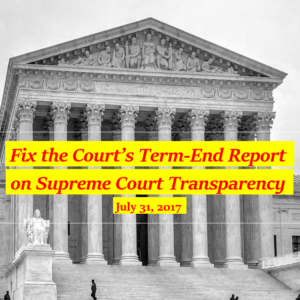Our Term-End Report Is Live!
 Fix the Court is taking a look at how the Supreme Court fared transparency-wise over the last 10 months, with the greatest strides being made via its new website that will support electronic filing; digital financial disclosures; justices’ stock selloffs; and courtroom livestreaming capabilities.
Fix the Court is taking a look at how the Supreme Court fared transparency-wise over the last 10 months, with the greatest strides being made via its new website that will support electronic filing; digital financial disclosures; justices’ stock selloffs; and courtroom livestreaming capabilities.
In addition, federal appeals courts not named “SCOTUS” became more open and accountable thanks to a rash of new broadcast and wellness initiatives.
“Though we’re pleased with several improvements that occurred this past term, the Supreme Court still has miles to go to comport with best practices in government transparency,” FTC executive director Gabe Roth said. “Fix the Court will continue to press for greater judicial openness and accountability as the only nonpartisan group in the country dedicated to these efforts.”
Here are the transparency highlights of OT16:
- The most important thing to happen to the Supreme Court in the last 10 months was the confirmation of Neil Gorsuch. In December, we had asked the U.S. Department of Justice to make public all non-classified Gorsuch-related material, and when we still hadn’t received them two months later, we sued. In March, prodded by our action, DOJ posted the bulk of them – 175,000 pages worth – online. Our suit remains pending, as DOJ has yet to give us or the public a good reason as to why 8,000 pages from his time in the agency remain secret.
- During the hearings themselves, Gorsuch was asked multiple times about his views on broadcast access to the courtroom and stronger ethics rules for the justices, and though his answers left much to be desired, we were pleased that our efforts to get these issues discussed were successful.
- On the circuit court level, we knew going into the term that only one (the Ninth) released live audio of its oral arguments. This spring we confirmed that another four are considering audio upgrades (the First, Fifth, Sixth and Seventh). A fifth (the Fourth) agreed to run live audio in a travel ban case in May. Additionally, the Third Circuit started recording video for the first time in January, and the Eleventh Circuit started releasing same-day argument audio in April.
- Thanks in part to our efforts, the audio-only Feb. 7 travel ban hearing in the Ninth Circuit was carried by CNN and countless online news outlets live and in its entirety. Listenership was greater than 1.5 million people.
- In a first, the justices on Nov. 4 allowed live audio from the courtroom, though not for an argument but for a bar meeting honoring Justice Scalia. The website, livestream.supremecourt.gov, is still up, and we hope it’s used as soon as next term for live dissemination of oral arguments and opinion announcements.
- We also knew that at least one circuit court (the Ninth) hosted a Judicial Wellness Committee aimed at promoting cognitive health in aging judges; this term we received confirmation that another five have similar committees or initiatives (the Third, Fifth, Seventh, Tenth and D.C.) and that another two were considering creating one (the First and Sixth).
- On Feb. 14, the House Judiciary Subcommittee on Courts, IP and the Internet held a hearing on judicial transparency and ethics at which a bipartisan group of members criticized the third branch for its lack of openness. Members from both parties suggested commonsense reforms that would counteract the declining faith in the courts system and previewed the introduction of broadcast bills that would cover all three levels of the federal courts system.
- For the first time, the federal judiciary released the justices’ annual financial disclosure reports via thumb drives and at no cost. Previous years’ reports had been distributed by paper at a cost of $0.20 per page.
- Chief Justice John Roberts and Justices Stephen Breyer and Samuel Alito sold up to $1.045 million in stocks in 2016 and reduced the number of individual securities they own to 53, compared to 60 at the end of 2015 and 76 at the end of the 2014.
- In addition to this transparency report, we released reports this term on the broadcast and retirement policies of foreign courts of last resort and of state supreme courts, on which top federal positions in all three branches are term-limited and why the justices recused themselves 204 times in OT16.